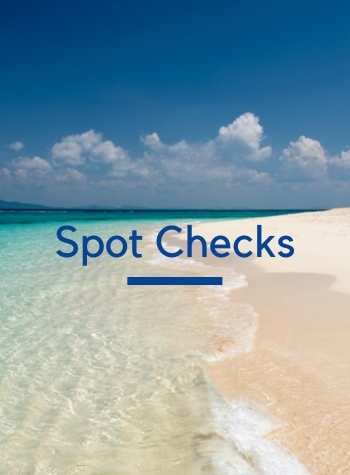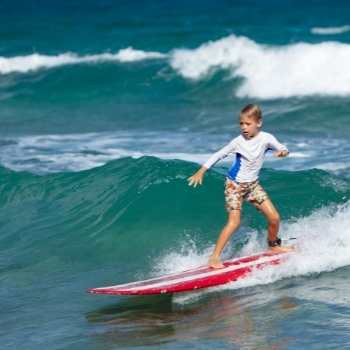When I first started surfing, I wanted my first board to be exactly what Kelly Slater was riding. I wanted to look cool and surf just like him and I thought that riding the same surfboard as the worldʻs best surfer would get me there. Oh, how young and naive I was.
A 6 foot surfboard is too small of a surfboard for anyone over the age of 5 years old to learn on. A good beginner surfboard has a rounded nose and a lot of volume, so that is stable and paddles well. A beginner should ride a fuller shaped surfboard between 7ʻ to 8ʻ for those under 5ʻ tall and boards between 8ʻ-10ʻ for anyone 5ʻ and up.
Learning to surf on the right sized board is hard enough. Having a surfboard that is too small for you will sabotage your surfing before you even get started. I know itʻs tempting to get a board like your favorite pro, but you gotta take baby steps.
I promise you, you will get there, but in due course!
Be a Good Beginner!
I remember my early days of surfing, a fellow surfer said a phrase that initially made me confused, then it made me laugh. He said “keep the cook in the kitchen”. At first, I thought maybe this man had gone mad, and that I probably shouldn’t surf with him. But when he saw my confused face, he explained to me the term kook (with a K).
Let’s just say, it’s not really a name we want to be called. It’s pretty much a negative term given to a newbie who hasn’t taken the time to learn the fundamentals and is a potential hazard out in the water. Yeah, not really something to strive for.
There are so many areas to focus on that give guidance on how you can avoid the kook label, and learn in an appropriate manner. First thing on the top of the list: get the correct size of board.
What’s the Difference between a Short and Long Board?
| Shortboard Vs. | Longboard |
| 5ʻ to 6ʻ in Length | 9ʻ to 12ʻ in Length |
| Pointed Nose | Rounded Nose |
| Low Volume, harder to paddle | High Volume, easier to paddle |
| Unstable When Popping up | Stable When Popping Up |
A shortboard, usually ranging between 5ft to 7ft in length and is significantly smaller than the longboard, which can vary between 9ft up to 12ft.
Shortboards commonly have a pointed nose and have 3 fins. These particular traits allow for a lightweight and streamlined surf, with increased speed and accuracy. With less buoyancy than a longboard, the surfer is required to do a bit more work to paddle out and catch the waves.
Learning to surf on a shortboard can, unfortunately, add time to the learning stage, simply put, and in a lot of cases, can completely dishearten a beginner, causing them to throw in the towel, which is the last thing I want for you!
Opposite to this, the longboard typically has 1 fin (but it isn’t uncommon to see them with 3 nowadays), a rounded nose, and a higher level of floatation. This creates a different kind of surf, more leisurely in my opinion, and ideal for a beginner.
Popping up on a longboard is much more stable and controlled than on a shortboard, simply because of the buoyancy and the larger surface area to maneuver the steps.
So as a beginner, it just doesn’t make sense to get a 6 foot board, when you need to give yourself the best foundations for learning first. If youʻre interested in learning more about the subject, you can read this post comparing which type of board is easier to ride.
Choosing the Best Surfboard for a Beginner
The aim of the game here is to progress as fast as possible without cutting corners. Pay your dues and leave your ego behind. Finding the best board will help you find your feet out in the water.
There are so many options out there that it’s easy to become overwhelmed. So here’s a list of the main features of a good beginner board:
- Stability
- Maneuvrability
- Paddling and wave catching potential
The way I look at it is like this: The more stability, the less maneuverability, and in the same way, the more buoyancy, the less speed.
The key here is knowing what you need as a beginner.
As a beginner, stability takes top spot over the fancy tricks and maneuvers and likewise, buoyancy takes the lead over speed (sorry to be the bearer of bad news). Taking these factors into consideration when choosing a surfboard is vital.
Foamies/soft top longboards are the ideal beginner board, simply because they are a product of all the benefits of different surfboards into one. The foam tops mean they float with ease, providing a nice, smooth paddle out and stability to help you pop up. Hereʻs one of the best that can be delivered straight to your door.
Confidence is key, for both a learner and an experienced surfer. I noticed myself gaining confidence in the water with a soft top over a hardtop, because I didn’t feel intimidated by my board. So forget about the stigma attached to using a foamie, and just get out there and start! Foam is our friend.
If you are looking for more detail on how to choose the right beginner surfboard, you are in luck. You can check out this recent blog post, The Complete Guide To Choosing The Best Beginner Surfboard. It will tell you all you need to know.
Can I Teach Myself to Surf?
I taught myself to sure. It took me a month to learn how to get to my feet, but I did it! Teaching yourself is possible, but you can cut that learning curve in half by getting some lessons, even if it is just for your first time.
If you’re wiser than me, and opt for a surf instructor, they will help you get the appropriate size of board for your height and weight, help you paddle out, time the waves for you and even give you that little push for momentum. Oh, and the fact someone is out in the water with you, it’s safer!
If you still insist on learning on your own without lessons (like me), check out this article that will equip you with everything you need to know to learn how to surf on your own.
So to wrap things up, there is no right or wrong answer to this question, everyone is different. But to get the best start in surfing, I highly recommend getting a bigger board than a 6ʻ surfboard to start off with.
Carve yourself an easier path to learning, it’s more enjoyable that way.



